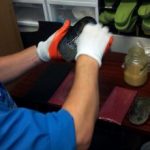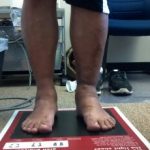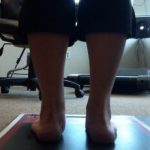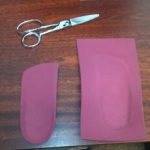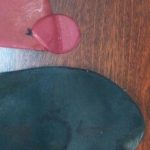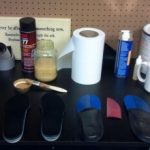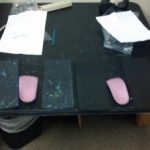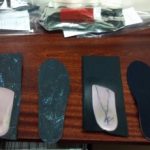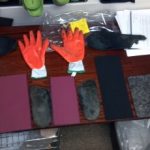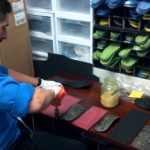 Custom orthotics are a treatment method for common running injuries like foot pain and knee pain. San Diego Running and Sports Injury Clinic can also fix, repair, refurbish/recondition and even transform your currently uncomfortable and useless orthotics into a comfortable orthotic that will help your condition. Typically repairing or refurbishing your orthotics is less than half the cost of a new pair of orthotics! To schedule your custom orthotic appointment call 858-268-8525 or TEXT: 858-322-8581 or email your questions to drallen@sdri.net and the doctor will answer them.
Custom orthotics are a treatment method for common running injuries like foot pain and knee pain. San Diego Running and Sports Injury Clinic can also fix, repair, refurbish/recondition and even transform your currently uncomfortable and useless orthotics into a comfortable orthotic that will help your condition. Typically repairing or refurbishing your orthotics is less than half the cost of a new pair of orthotics! To schedule your custom orthotic appointment call 858-268-8525 or TEXT: 858-322-8581 or email your questions to drallen@sdri.net and the doctor will answer them.
What Is A Custom Orthotic?
A custom orthotic is a device made and customized to the shape of your foot. It is meant to stabilize the foot and hold it in an optimal position, increase function, limit motion of a painful joint, decrease weight bearing on painful areas and protect your foot from excessive impact and shearing forces.
How Much Does a Custom Orthotic Cost?
Custom orthotic prices vary depending on the place you purchase them and the knowledge, experience and expertise of the person making them. We make true custom orthotics. Our molding process is done in house and we physically hand craft your orthotics. The cost of San Diego Running & Sports Injury Clinic custom orthotics is $447 for one pair or $800 for two pairs. You can choose whether you have one pair for dress shoes and one for running or if you prefer you can have two pair for running or athletic shoes
San Diego Custom Orthotics are made at the San Diego Running & Sports Injury Clinic. Custom orthotics are generally made to correct muscle imbalances and over-pronation during walking and running, prevent knee pain in running and jumping sports, and to correct leg length differences.
What Are Custom Orthotics Used For?
Custom orthotics assist with some common foot/leg issues that can result in pain or injury, including:
Structural Imbalances
Your foot is an adaptable unit comprised of 26 bones. It has the ability to accommodate to various terrains by flexing and spreading out as well as the ability to become a firm lever for push-off during walking and running. Structural and positional deformities of the feet or lower limb can negatively influence foot function during walking and running.
San Diego Custom Foot Orthotics are used to decrease abnormal compensation. The most common abnormal compensation is termed over-pronation. Over-pronation is when the foot rolls excessively inward towards your midline resulting in excessive, abnormal stresses on the knees and back resulting in pain injury. San Diego Custom Orthotics are effective in returning runners to previous levels of activity.
Pronation and Supination
Excessive pronation is movement of the ankle towards your midline during the stance phase of the gait cycle (insert picture). With this excessive, abnormal movement at the foot and ankle comes excessive, abnormal internal rotation of the tibia resulting in shearing forces at the knee. When the knee rotates inward the hip and pelvis follow resulting in shearing forces at the hip and sacroiliac joints. Depending on how a runner or walker compensates will dictate where injuries occur.
No two runners or walkers compensate the same. However, the same injuries usually occur in the same areas but for different compensations.
San Diego Custom Orthotics decrease excessive pronation and excessive shearing forces at the knee, hip and lower back. In this way the quadriceps angle is effectively reduced and your Vastus Medialis Oblique is allowed to function without inhibition. Very few walkers or runner’s actually over-supinate. Supination results during the gait cycle during push-off. After your foot comes in full contact with the ground and is in its maximally pronated position then the motions are reversed and your foot supinates, becomes a rigid lever and you are able to then effectively push-off your big toe.
Shock Absorption
San Diego Custom Orthotics provide shock absorption during walking, running and other athletic activities. Runners and walkers with high arched, rigid feet typically have trouble with absorbing shock due to their foot’s inability to flex and dissipate force on impact. This type of foot requires and flexible, soft orthotic, not a hard rigid device.
Shearing Forces
San Diego Custom Orthotics decrease shearing forces. Many runners develop knee pain that worsens with increased running miles. This is generally a result of excessive shearing forces at the knee and kneecap resulting in a condition known as Chondromalacia (runner’s knee) or another common condition called Iliotibial Band Syndrome.
By changing the way your foot interacts with the ground San Diego Custom Orthotics change the way the forces affect your knee decreasing knee pain and making running enjoyable again.
Injuries
Some of the injuries successfully treated with custom orthotics are:
- Piriformis Syndrome
- Hip Bursitis
- Lower Back Pain/Sciatica
- Chondromalacia (Runner’s Knee)
- Patella Tendonitis (Jumper’s Knee)
- Knee Arthritis
- Iliotibial Band Syndrome
- Shin Splints
- Achilles Tendonitis
- Heel Spurs
- Plantar Fasciitis
Frequently Asked Questions (FAQs) About Custom Orthotics
Read on for more detailed information to frequently asked questions about custom orthotics and San Diego Custom Orthotics.
What are Custom Orthotics?
A custom orthotic is a device made and customized to the shape of your foot. It is meant to stabilize the foot and hold it in an optimal position, increase function, limit motion of a painful joint, decrease weight bearing on painful areas and protect your foot from excessive impact and shearing forces.



Custom orthotics – also known as custom insoles or even custom foot beds – are commonly prescribed and used in the treatment of running and other athletic injuries involving the lower extremity. Your lower extremity consists of your hip, thigh, knee, leg, calf, ankle and foot. Custom insoles can be used to correct abnormal alignment of your foot which can have a negative effect on the rest of your lower extremity. For example, if your foot pronates excessively it can cause your ankle to roll inward while walking and even more so when running. Because your knee is attached to your ankle via your leg/calf your knee will also twist inward if you over-pronate. Of course your hip is connected to your knee via your thigh and it to will twist inward if you over-pronate. Since your body is mechanically connected it is functionally related. By supporting your feet mechanically you will improve your function throughout your body.
What is an over the counter orthotic?
An over the counter orthotic differs from a custom as they are prefabricated on an assembly line with the left and right being identical. For those whose feet are identical in length, width and arch height they may be suitable and help alleviate a certain condition. Very few people are perfectly symmetrical and therefore it is common for an over the counter orthotic to not work effectively. Often an over the counter orthotic helps the condition “a little”. This typically indicates that a San Diego Custom Orthotic will dramatically alleviate pain and symptoms condition.
How do we customize your orthotic?
Dr. Allen does not use an outside orthotic lab but instead takes the mold during your visit and then actually makes and customizes them himself for you. This approach minimizes cost and turn-around time for the patient with most patients having their orthotics in hand within 7-10 business days after the mold is taken.
Once the patient receives the orthotics they wear test them and report back to Dr. Allen via email (so there is no $ office visit) letting him know if they perceive any discomfort or if they feel they can be improved upon. At that point at no additional cost to the patient Dr. Allen will modify the orthotics to be both more comfortable and more effective.
.jpg) Who needs orthotics?
Who needs orthotics?
If you consistently develop pain as you increase your miles then you are probably a San Diego Custom Orthotic candidate. Unlike injuries that occur at a specific moment in time, like an ankle sprain, over-use conditions typically develop due to a repetitive motion. If you plan on continuing in a sport and thus continuing to perform that same repetitive motion than you must have an orthotic to help decrease the abnormal motion and forces acting on your joints.
In a study done by Blake and Denton (1985) runners treated for plantar fasciitis, shin splints, chondromalacia (runners knee), medial quadriceps strain and patellar tendonitis with custom orthotics reported, 83% felt they were worth the expense, half obtained 90% relief and 75% felt the orthotics improved their running. Not all research on orthotics is positive but there is a simple reason for this. Many doctor’s and therapists prescribe hard rigid orthotics which limit the foot’s motion and actually cause pain in many patients.
A foot has 26 bones and 55 joints because it is supposed to move and have the ability to flex and dissipate impact forces. Hard, rigid orthotics prevent this from happening. San Diego Custom Orthotics are semi-rigid and flexible. They do not stop motion but support it which results in decreased shearing forces in addition to absorbing shock. San Diego Custom Orthotics work synergistically with your running shoe to dissipate impact forces and prevent injury to the runner.
How do you know which type of Orthotic is right for your foot and/or injury?
Dr. Allen has created several helpful videos which break down the differences between custom orthotics, molded orthotics, and over the counter orthotics. Discover the pros and cons of each type, and learn how to avoid being scammed by fake “custom” orthotics that some running shoe stores offer.
Why San Diego Custom Orthotics?
San Diego Custom Orthotics are heat molded to your foot at the time of your appointment. So they are formed to your foot while you are present. In the case of most custom orthotics a plaster mold is taken of your foot, you step in foam leaving an imprint of your foot or you stand on a digital pad leaving an electronic imprint. These are then sent to a lab where the lab technician decides how they will mold your orthotic so that you walk or run better and without pain. The problem with this is the technician is not a doctor, did not physically see your foot, take your history nor understand your condition. Finally after $600-$1000 and 3 weeks of waiting your hard orthotics are ready. As you eagerly put them in your shoes hoping they will fix your condition you are disappointed because they are uncomfortable and seem to actually hurt your foot more than without them. The doctor or therapist says you will have to “break them in” or “get use to them”. What they are telling you is you will get used to them being uncomfortable!
San Diego custom orthotics are made using heat molds which are taken at the time of your appointment at the San Diego Running & Sports Injury Clinic. The cost is $447 for one pair or two pair for $800….one for running shoes and one for dress shoes. Or perhaps you prefer 2 pair for running. Our custom orthotics are typically ready for you within seven days. At this time you return to try the orthotic, run in it and leave with it for a “try out”. About 75% of the time they are perfect and your condition is significantly improving. Sometimes the orthotic is effective but for some reason uncomfortable. We then have the runner return for modifications at no additional cost. Modifications are typically ready within 1-3 days. San Diego Custom Orthotics typically last 1-2 years or slightly longer depending on the amount of use and the environment you are using them in. The actual orthotic portion will last years but the top cover can wear out. This can be replace for a small fee.
Repairing, Refurbishing and Transforming Existing Orthotics
San Diego Running Institute can also fix, repair, refurbish/recondition and even transform your currently uncomfortable and useless orthotics into a comfortable orthotic that will help your condition. Typically repairing or refurbishing your orthotics is less than half the cost of a new pair of orthotics!
- Resurface Fee: $87 – includes removing the existing top covers and replacing them with new top covers.
- Refurbish Fee Level 2: $167 – includes removing top covers and any simple modifications and replacing the existing top covers.
Patient Questions About Custom Orthotics
Read Dr. Allen’s personal responses to questions that real patients have submitted.
My podiatrist watched me walk across his office, told me I pronate and need $800 orthotics. Should I trust him/her?
The fact that you are asking tells me you are suspicious anyway. No one can watch you walk across their office barefoot or down a hall and see anything of value! In addition walking and running mechanics are different! I love the kid at the local running store who claims you “over-pronate’ and need more “stability”. Most of them could not tell you how much pronation is too much if asked.
Next time you are in that situation have a little fun. When the kid tells you that they see you over-pronating ask this simple question. “How many degrees of pronation is too much?” or “How many degrees of pronation is normal?” Watch their eyes bug out at this question. In fact most doctors do not even know the answer to the question.
I asked this question once during a Podiatric Convention in Las Vegas. I asked the keynote speaker, “How do you define over-pronation”? He replied, “I know it when I see it”. Wow, I thought. “Actually it can be measured”, I replied. “We use motion analysis software to slow the runner’s motion down and then stop it during the gait cycle at what is called mid-stance. We then use math to measure the angles at their feet, ankles, knees and hips so that we can compare their motion to normal motion. “
I already have custom orthotics and they did not help. What do I do now?
This is a problem I encounter daily. It is not unusual for an injured runner to show me an expensive pair of custom orthotics they purchased that are not effective at alleviating their running injury. Our San Diego Orthotic lab provides a simple solution to this common problem. We can save you a lot of time and money because of our ability to modify and customize the insoles you already purchased. Rather than taking new molds we can work with your existing molds by modifying them in 2 extremely important ways.
- We can make them comfortable.This is the most important trait for an orthotic. If it is not comfortable or does not fit well in your shoe you can’t or will not wear it. We can make it comfortable by making it more flexible and/or making it softer. Think of your orthotics like a blank canvas. What you create on that blank canvas is entirely up to you. At your appointment I will go over all of your options and explain how I can make your existing orthotic work better and be more comfortable. This process typically costs about half of what making a new custom insole costs.
- We can make them effective. An orthotic must be comfortable first…..and effective second or else it is functionally useless to you as it is not helping your injury. The process of making an orthotic more effective is done by customizing your existing orthotic mold. There are various types of custom orthotic accommodations that are intended to relieve pressure on a specific type of injury or promote normal biomechanics. A simple example of this can illustrate the point. Imagine if your orthotics cause you pain because the arches are too high. If the arches are too high they might push up too aggressively on your foot causing you pain. Your doctor or therapist may have told you to “get use to it”. This is a ridiculous demand as it causes you pain so you stop wearing them altogether deeming “orthotics did not help me”. I can take your orthotic and within days have the arch lowered or made more flexible so that when you run, walk or stand on them there is no discomfort. Another common example would be a patient telling me “the orthotics is too hard”. No problem, within days I can take the orthotic apart, strip it “to the bone” and then rebuild it using softer materials such as cushion neoprene and memory foam that are intended for high impact sports. I love seeing the look of pleasure and amazement when someone returns for their custom orthotic fitting and instantly knows their orthotic is now comfortable.
The big picture is that in order to be effective an orthotic must be comfortable. Not all orthotics are the same and there is a wide range of materials that can be used to re-work your orthotic.
What is the difference between over the counter insoles like Dr. Scholl’s and the Custom Orthotics you make?
This is a common question I get. The main difference is that over the counter orthotics or insoles such as Dr. Scholl’s or Superfeet are molded to a generic foot. Since most people have a difference in foot size from right to left it is common for the insole to not support the correct areas of one foot and can also be uncomfortable or ineffective. A true custom orthotic is molded to your foot so that it hits you in all the right spots resulting in symmetrical support. This is accomplished through a molding process.
There are many ways to take molds. Some still use the 1950’s plaster of Paris mold then ship it off to a lab where they transfer the mold to plastic. Some use a foam box that takes your foot impression. The foam box is then shipped off to the lab where they transfer the mold to plastic. Some even use a computer scanner that you stand on or walk on. That image is transmitted electronically to a lab where they convert it to plastic.
At San Diego Running Institute I either heat mold the plastic to your foot while you are here or use an injectable mold and mold it to your foot during your appointment. I never ship anything to a lab because we have our own lab on site. This ensures quality control and expedites orders. In the past, when I used a lab it would often take 2 weeks to receive the orthotic and all too often there would be comfort issues with the insole. Our normal turn-around time is 5-7 days because we cut out the “middle-man” (lab). During the fitting process if there are comfort issues I can usually resolve them. In addition, San Diego Running & Sports Injury– orthotics are not “old school”, hard, rigid orthotics. We use flexible and semi-flexible materials to ensure comfort and maximum performance.
What is the difference between a molded orthotic and a custom orthotic?
This is another question I frequently get asked regarding insoles. A molded insole is simply the mold of your foot. Instead of using an over the counter insole you may have had insoles molded to your feet. A true custom insole will not only utilize the molds of your feet but the molds will be customized to offset any abnormal mechanics of your foot and ankle such as over-pronation. A simple mold of your foot does nothing except represent the shape of your foot. Customizing the mold and offsetting excessive pressure or abnormal mechanics is what makes an insole custom.
To reiterate, a custom mold is just that….a mold of your foot. It does nothing to offset any abnormal mechanics. For example, if your ankle was dislocated and a mold was made of it how would that help you? It would not because your ankle is still dislocated! Now if the mold was customized to push the ankle back into alignment and support it there by adding custom pieces to it then it would be custom.
At our San Diego Orthotic Lab the molds are taken by the doctor, not kids or other inexperienced, non-qualified personnel. The molds are customized by the doctor in our laboratory and then the new custom orthotics are fitted into your shoes.
Orthotics are expensive so I can’t afford them. What are my options?
In my opinion San Diego Running Institute Orthotics are actually inexpensive – I should probably raise the price! We make the custom orthotics and provide 2 modifications/changes at no additional cost to the $447 for one pair or $800 for two pair that we charge.
Some foot doctors charge as much as $1000. Most of these foot doctors will take a mold and send it to an anonymous lab. The lab will convert your mold into an orthotic shell and then send it back to the foot doctor roughly 2 entire weeks later. He/she will then tell you to “get use to it” and send you on your way. This process does not work for many and they end up with orthotics they do not wear.
At our on-site San Diego orthotic lab I personally mold your foot during your appointment using the best custom orthotic molding process available. I then customize the insole based on your weight, miles run, arch height, pronation and biomechanics so that it is both comfortable and effective. This process takes 7-10 days instead of 3 weeks because I do not have to ship your mold to a lab and then wait for them to make it and ship it back!
If any minor adjustments need to be made to the orthotic I do it right then, during you office visit.
After running in the orthotics I developed a blister. They are uncomfortable. What should I do now?
If you have a pressure point of hot spot from the orthotic it simply means it is too aggressive in that area and needs to be adjusted. Not a problem! Simply let me know via email what the problem is, take a picture of your foot and mark the spot on the orthotic you believe to be the problem spot. I’ll tell you the most advantageous time to drop your orthotic for a modification so that you will only be without them for 2-5 days.
Your other option would be to schedule a paid appointment and have your orthotics modified while you wait so you are not without them at all. It is not unusual to have to modify an orthotic once…maybe twice at the most. For this reason up to two modifications are included in our $447 price. There is no reason to “get use to it”. My goal is to make your orthotics comfortable and effective and I am willing to do whatever it takes to achieve that goal.
I have been making orthotics for runners and walkers alike for years. I have used over 10 different lab’s finding one to be worse than another. For this reason I was “forced” into learning the art of creating custom orthotics. Because of my passion to help runners achieve their goals I was determined to find a way to make their orthotics both comfortable and effective. What I found was this can sometimes require patience, both on my part and the person getting the orthotics.
My years of experience has taught me that “If at first you don’t succeed, try again”. My experience has given me the understanding that running has impact. If you try to place a hard, rigid insole under a runners foot that only worsens the impact. Running also requires motion. If you place a hard, rigid orthotic beneath a runner’s foot it prevents motion. Preventing motion in runners by using a hard, rigid insole will almost certainly cause problems because it defies normal body mechanics. For this reason our custom insoles are either semi-flexible or flexible depending on the design. Lastly, my experience has shown that it is not uncommon to have to modify an orthotic to enhance its comfort or effectiveness. For this reason I have built in 2 modifications into our orthotic price of $447 or two pair for $800.
Custom Orthotics Pictures – See How They’re Made!
- Custom Orthotics must be comfortable and effective to fix Runners Knee
- Repairing your existing orthotics
To schedule your custom orthotic appointment call 858-268-8525 or TEXT: 858-322-8581 or email your questions to drallen@sdri.net and the doctor will answer them.

